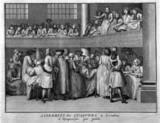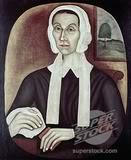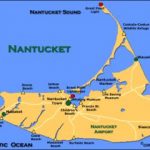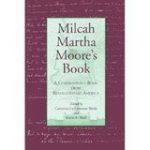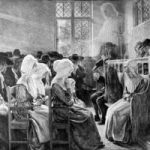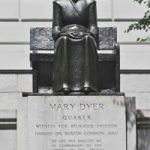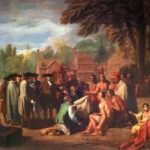Quaker Woman
Image: Assembly of Quakers
A woman preaches before an assembly of Quakers in London in 1723.
Early Life
Little is known about Elizabeth Ashbridge beyond what is recorded in her brief autobiography, Some Account of the Fore Part of the Life of Elizabeth Ashbridge, first published in England 1774. The book is a frank account of her unhappy marriage and her search, with the help of various religious groups, for a sincere religious faith. It is remarkable both as the spiritual testament of an intelligent and courageous woman, and also as a revealing (and often unflattering) depiction of life in colonial America in the first half of the 18th century.
Elizabeth Ashbridge was born in 1713 in the town of Middlewich in Cheshire, England to Thomas and Mary Sampson. Thomas was a surgeon on sea vessels, and Mary was a pious follower of the Church of England. When Elizabeth turned 14, she married a miserly stocking weaver several years her elder without parental consent, only to become a widow five months later.
In Exile
Her marriage had driven a wedge between Elizabeth and her father, and he refused to accept her back to her childhood home. So she was sent to Dublin, Ireland, where she lived with some of her mother’s relatives.
The relation I went to reside with was one of the people called Quakers. His habits were so very different to what I had been accustomed to, that the visit proved disagreeable to me. I had been brought up in the way of the Church of England, and though, as I have said, I had a religious education, yet I was allowed to sing and dance, which my cousin would not permit.
The great vivacity of my natural disposition would not, in this instance, suffer me to give way to the gloomy sense of sorrow and conviction; and therefore my present restraints had a wrong effect. I became more wild and airy than ever; my cousin often reproved me; but I then thought his conduct was the result of singularity, and would not bear it, or be controlled.
Having a distant relation in the West of Ireland, I went to him. I now enjoyed all the liberty I wished; for, what rendered me disagreeable to my other kinsman, was quite pleasing to this. Between these two relations I spent three years and three months.
My father still keeping me at such a distance, I thought myself quite excluded from his affections, and therefore resolved not to return home. I became acquainted with a gentlewoman lately arrived from Pennsylvania who was intending to return, and as I had an uncle, my mother’s brother, in this province, I soon agreed with her for my passage.
I was ignorant of the nature of an indenture and suffered myself to be bound. This was done privately, that it might not be found out. As soon as it was over, she invited me to see the vessel in which I was to sail. I readily consented, and we went on board, where there was another young woman who, as I afterwards found, was of a respectable family and had been brought there in the same way as myself.
Despite all these troubles, Elizabeth emigrated to the American colonies as an indentured servant, arriving in New York in July, 1732, where she was sold to a brutish man. During her service, she managed to work odd jobs to pay off her last year of the contract. It was during this time that she met her second husband, a teacher with a penchant for violence and drink named Sullivan.
The Quakers
Despite her initial distaste for the practices of the Society of Friends (Quakers), Elizabeth was drawn to the beauty and eloquence of their faith. Sometime during her second marriage, she set out from her home in Long Island to visit relatives in Philadelphia, where she experienced a conversion from the Anglican religion of her youth to Quaker beliefs.
Her husband, Sullivan, felt deeply threatened by this development and demanded that she live her life by his side roaming the various colonies. He complained that her new beliefs made her a more somber and self-directed woman, alienating the husband who had loved her for her mirthful nature. Ultimately, Sullivan could not keep Elizabeth from her religious practice, and eventually she became a Quaker minister.
Sullivan even began displaying mild interest in Quakerism. One night in a drunken stupor, he enlisted in the army and was soon called to serve, but he refused, claiming his Quaker religion as the reason. This resulted in a horrific beating that hospitalized him and ultimately killed him in under a year.
Five years later, Elizabeth married a third husband, Aaron Ashbridge, who was a well known and respected member in the Quaker community in Chester County, Pennsylvania.
In the ninth month, 1746, we were married at Burlington, West Jersey. The company of each other was dear and delightful, but the time came when we must part. Sufficiently convinced that her Lord and Master called for her services abroad, my heart was willing to give up the darling object of its love.
Though it has pleased the Divine Will to remove her without indulging my longing desire to see her again, yet fully satisfied that she is called from the troubles of time to a happy eternity, I am resigned and enjoy a grateful composure of mind. She left home the 11th of the fifth month, 1753, and died in Ireland, the 16th of the fifth month, 1755.
~Aaron Ashbridge
SOURCES
Elizabeth Ashbridge
The Life of Elizabeth Ashbridge
Elizabeth Ashbridge Becomes a Quaker
Elizabeth Ashbridge in Heath Anthology
